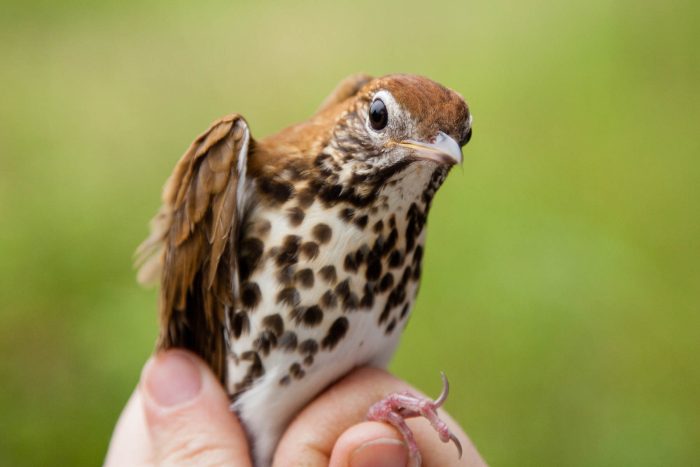Wood Thrush
Hylocichla mustelina
The wood thrush is the official bird of the District of Columbia, known for its small size, cinnamon-colored feathers and black-spotted belly.
This section shows one large critter image at a time. Use the thumbnails that follow to select a specific image to display here.

This gallery contains a grid of small thumbnails. Selecting a thumbnail will change the main image in the preceding section.
Appearance
Wood thrush are small, just bigger than a sparrow, with warm, cinnamon-colored feathers, and brownish-black spots on their belly. Its cheeks are streaked, and eyes outlined boldly in white. Juvenile patterns are paler than adults.
Feeding
The wood thrush feeds primarily on soil invertebrates and larvae, but will also eat fruits, insects, snails, and small salamanders. Feeding mainly on the forest floor, wood thrush can be found hopping around in leaf litter, probing the soil for insects. Their bill is used to sort through leaves to reveal its prey.
Predators
Wood thrush eggs and chicks are vulnerable to many predators like chipmunks, raccoons, crows, snakes, squirrels and mice. Adults commonly fall prey to owls and hawks. When predators are near, wood thrush becoming highly alert, ready to respond with agitated calls and chases, escalating to dives and strikes.
Flight
Wood thrush fly fast and low to the ground to search for food. In courtship, a female will initiate pairing by enticing a male to chase her in silent circular flights three to six feet above the ground. Additionally, flight is the usual method in avoiding threats.
Reproduction and life cycle
Breeding pairs form from mid-April to early-May. Females will choose their nest site and begin construction in a tree or shrub using dead grasses, stems or leaves, and lined with mud. When ready, the female lays two to four eggs, which she incubates for 11-14 weeks. While the female broods the chicks for the first four days, both the male and female feed the chicks and remove fecal sacs from the nest. The chicks will fledge from the nest 12 to 15 days after they are hatched and will continue to be fed until they are 21 to 31 days old. These chicks will begin breeding the following summer. Wood thrush typically live to about 9 years.
Did you know?
The wood thrush is the official bird of the District of Columbia.
Brown-headed cowbirds are known to lay their eggs in wood thrush nests; yet, unlike other bird species, wood thrush take them in as their own.
The wood thrush can harmonize with itself by singing multiple notes simultaneously.
When squaring off against other males, instead of song-matching, wood thrush almost always answers a rival’s song with a different one.
Sources and additional information
All About Birds – The Cornell Lab of Ornithology
Animal Diversity Web – University of Michigan Museum of Zoology
